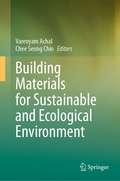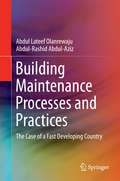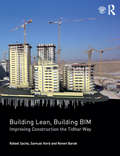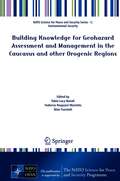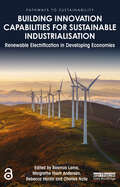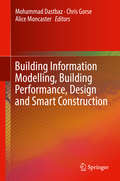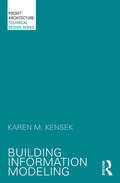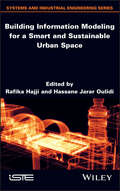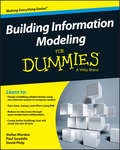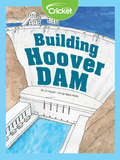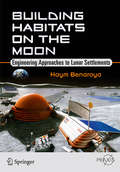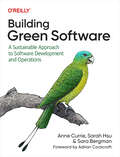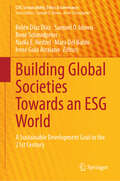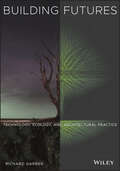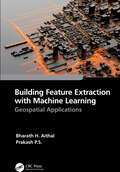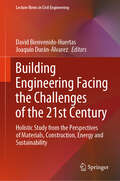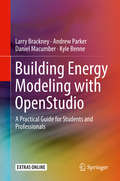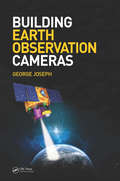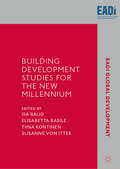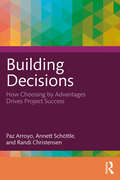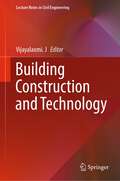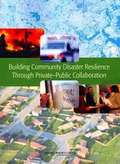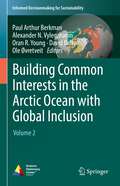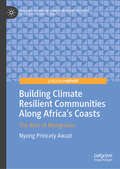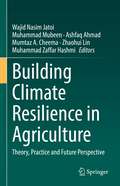- Table View
- List View
Building Materials for Sustainable and Ecological Environment
by Varenyam Achal Chee Seong ChinThis book uses theories, hypotheses, policies, practical insights and case studies to introduce and elucidate green building materials for sustainable construction. Cement is the most widely used building material in construction; however, it is not sustainable, being responsible for 7% of global carbon dioxide emissions and consuming huge quantities of energy. In order to limit the ecological damage, sustainable building materials are needed. Ecosystems are a source of important lessons and models for transitioning the built environment onto a sustainable path that opens options for sustainable building material in construction. The book provides a guide for readers seeking knowledge on sustainable building materials with the potential to lower environmental impact by reducing CO2 emission throughout the building’s lifecycle. The book is motivated by recent rapid advances in sustainable building materials production, including green building materials made of industrial by-products and recycled wastes, earth materials, plant-based materials, microbial-based materials or supplementary cementitious materials, to reduce the environmental impacts of traditional building materials. Discussing the development and applications of various sustainable building materials, including related case studies, and addressing the environmental issue with a holistic and systematic approach that creates an ecology of construction for sustainability in infrastructures, it offers promising solutions to achieve renewable and sustainable building materials for the future.
Building Maintenance Processes and Practices: The Case of a Fast Developing Country
by Abdul Lateef Olanrewaju Abdul-Rashid Abdul-AzizThis book is designed to be an inclusive for the best practice approach to building maintenance management, where the processes, procedures and operational systems meet a high standard of professional and academic competence. It offers a different perspective on building maintenance management by presenting the schematic building maintenance value chain model and it's implementation in Malaysian university buildings. The findings show an improvement to building performance, lower maintenance cost, building sustainability and increased maintenance service user satisfaction. The learning outcomes and summaries provided for each chapter and the extensive use of tables and figures add to the readability of the text. Though the book is based on data from Malaysia, it is useful for a much wider audience, and the informal writing style makes it an interesting reference source. This book is valuable for readers who are practitioners, professionals and for academic institutions that offer courses in the building field, including architecture, quantity surveying, civil engineering, building and facility management, property management, real estate. It will also be of interest to governments and others involved in the construction industry.
Building Lean, Building BIM: Improving Construction the Tidhar Way
by Rafael Sacks Samuel Korb Ronen BarakBuilding Lean, Building BIM is the essential guide for any construction company that wants to implement Lean Construction and Building Information Modelling (BIM) to gain a strategic edge over their competition. The first of its kind, the book outlines the principles of Lean, the functionality of BIM, and the interactions between the two, illustrating them through the story of how Tidhar Construction has implemented Lean Construction and BIM in a concerted effort over four years. Tidhar is a small-to-medium-sized construction company that pioneered a way of working that gave it a profit margin unheard of in its market. The company's story serves as a case study for explanation of the various facets of Lean Construction and BIM. Each chapter defines a principle of Lean and/or BIM, describes the achievements and failures in Tidhar's implementation based on the experiences of the key people involved, and reviews the relevant background and theory. The implementation at Tidhar has not been a pure success, but by examining their motives alongside their achievements and failures, readers will learn about what pitfalls and pinnacles to expect. A number of chapters also compare the experience of Tidhar with those of other companies who are leaders in their fields, such as Skanska and DPR. This book is highly relevant and useful to a wide range of readers from the construction industry, especially those who are frustrated with the inefficiencies in their companies and construction projects. It is also essential reading for Lean and BIM enthusiasts, researchers and students from a variety of industries and backgrounds.
Building Knowledge for Geohazard Assessment and Management in the Caucasus and other Orogenic Regions (NATO Science for Peace and Security Series C: Environmental Security)
by Fabio Luca Bonali Federico Pasquaré Mariotto Nino TsereteliThis volume is aimed at providing a comprehensive overview of the state of art of research related to geo-related hazards in the Caucasus and other orogenic regions; it is also devoted to shedding light on a broad array of geological phenomena as well as discussing innovative tools and strategies for geohazard assessment. Additional emphasis is placed on preventive and mitigation measures, which might be helpful in tackling seismic, volcanic and landslide risks affecting major lifelines and infrastructures. The innovative, multidisciplinary methodologies illustrated in this volume may be successfully applied to other orogenic regions across the globe. The book features major scientific contributions from experts working on different Earth Science topics, such as seismology, structural geology, applied geology and volcanology. Its chapters describe a wide gamut of cutting-edge research methodologies and are thus intended to be read and shared by the worldwide Earth Science community. In particular, the readers will have a chance to gain a thorough knowledge of a number of key geological features that can be observed across both the Greater and Lesser Caucasus. Moreover, the volume provides a thorough description of the techniques employed to assess seismic hazard in major cities - such as microzonation - and an overview of the efforts taken to monitor and prevent seismic and landslide hazard posed to vital energy infrastructures in the Caucasus region.
Building Innovation Capabilities for Sustainable Industrialisation: Renewable Electrification in Developing Economies (Pathways to Sustainability)
by Rasmus Lema, Margrethe Holm Andersen, Rebecca Hanlin and Charles NzilaThis book argues that renewable electrification in developing countries provides important opportunities for local economic development, but new pathways are required for turning these opportunities into successful reality. Building Innovation Capabilities for Sustainable Industrialisation offers a novel input into the debate on development of capabilities for sustainable industrialisation and delivers key insights for both researchers and policy makers when it comes to the question of how to increase the economic co-benefits of renewables expansion. The chapters in the book use a tailored analytical framework in their studies of renewable electrification efforts in Kenya and other countries in sub-Saharan Africa. They draw on a mix of project, sector and country level case studies to address questions such as: What capabilities are developed through on-going renewable electrification projects in developing economies? How can the expansion of renewable electrification be supported in a way that also encourages sustainable economic development? What role do international linkages (South-South and North-South) play and what role should they play in the greening of energy systems in developing economies? The authors provide a new understanding of how green transformation and sustainable industrialisation can be combined, highlighting the opportunities and constraints for local capability building and the scope for local policy action. This book will be of great interest to students and scholars of development studies, energy studies, sustainability and sustainable development, as well as practitioners and policy makers working in development organisations and national governments.
Building Information Modelling, Building Performance, Design and Smart Construction
by Mohammad Dastbaz Chris Gorse Alice MoncasterThis book charts the path toward high performance sustainable buildings and the smart dwellings of the future. The volume clearly explains the principles and practices of high performance design, the uses of building information modelling (BIM), and the materials and methods of smart construction. Power Systems, Architecture, Material Science, Civil Engineering and Information Systems are all given consideration, as interdisciplinary endeavours are at the heart of this green building revolution.
Building Information Modeling: Bim In Current And Future Practice (PocketArchitecture)
by Karen M. KensekThis is a design guide for architects, engineers, and contractors concerning the principles and specific applications of building information modeling (BIM). BIM has the potential to revolutionize the building industry, and yet not all architects and construction professionals fully understand what the benefits of BIM are or even the fundamental concepts behind it. As part of the PocketArchitecture Series it includes two parts: fundamentals and applications, which provide a comprehensive overview of all the necessary and essential issues. It also includes case studies from a range of project sizes that illustrate the key concepts clearly and use a wide range of visual aids. Building Information Modeling addresses the key role that BIM is playing in shaping the software tools and office processes in the architecture, engineering, and construction professions. Primarily aimed at professionals, it is also useful for faculty who wish to incorporate this information into their courses on digital design, BIM, and professional practice. As a compact summary of key ideas it is ideal for anyone implementing BIM.
Building Information Modeling for a Smart and Sustainable Urban Space
by Hassane Jarar Oulidi Rafika HajjiUrban spaces are being called upon to develop a capacity for resilience and sustainability in order to meet the major challenges they face. To achieve such a goal, a practical development framework must be implemented in order to take advantage of the technological innovations that characterize the field of construction and urban engineering. Today, multi-scale BIM is bringing about significant changes that are redefining the paradigms of urban management. It facilitates simulations of the sustainability of urban spaces with respect to several criteria; most notably relating to energy, the economy and the environment.Building Information Modeling for a Smart and Sustainable Urban Space proposes a theoretical and practical framework for implementing BIM models for the creation of sustainable and intelligent urban spaces. It addresses the issues of acquisition, modeling, interoperability, and BIM and GIS integration for the production of BIM models. Case studies are presented, providing a practical dimension that demonstrates the production process of the urban model and its contribution to multiscale simulations, particularly in real estate evaluation and urban renewal.
Building Information Modeling For Dummies
by Stefan Mordue Paul Swaddle David PhilpEverything you need to make the most of building information modeling If you're looking to get involved in the world of BIM, but don't quite know where to start, Building Information Modeling For Dummies is your one-stop guide to collaborative building using one coherent system of computer models rather than as separate sets of drawings. Inside, you'll find an easy-to-follow introduction to BIM and hands-on guidance for understanding drivers for change, the benefits of BIM, requirements you need to get started, and where BIM is headed. The future of BIM is bright—it provides the industry with an increased understanding of predictability, improved efficiency, integration and coordination, less waste, and better value and quality. Additionally, the use of BIM goes beyond the planning and design phase of the project, extending throughout the building life cycle and supporting processes, including cost management, construction management, project management, and facility operation. Now heavily adopted in the U.S., Hong Kong, India, Singapore, France, Canada, and countless other countries, BIM is set to become a mandatory practice in building work in the UK, and this friendly guide gives you everything you need to make sense of it—fast. Demonstrates how BIM saves time and waste on site Shows you how the information generated from BIM leads to fewer errors on site Explains how BIM is based on data sets that describe objects virtually, mimicking the way they'll be handled physically in the real world Helps you grasp how the integration of BIM allows every stage of the life cycle to work together without data or process conflict Written by a team of well-known experts, this friendly, hands-on guide gets you up and running with BIM fast.
Building Hoover Dam
by Liz HuyckHave you ever wondered how the Hoover Dam was built? Follow along as the Colorado River itself tells you its story! A lot of work went into the construction of this giant dam, but it was worth it—we now have Lake Mead and a way of converting the river’s energy into electricity!
Building Habitats on the Moon: Engineering Approaches to Lunar Settlements (Springer Praxis Books)
by Haym BenaroyaDesigning a habitat for the lunar surface? You will need to know more than structural engineering. There are the effects of meteoroids, radiation, and low gravity. Then there are the psychological and psychosocial aspects of living in close quarters, in a dangerous environment, far away from home. All these must be considered when the habitat is sized, materials specified, and structure designed. This book provides an overview of various concepts for lunar habitats and structural designs and characterizes the lunar environment - the technical and the nontechnical. The designs take into consideration psychological comfort, structural strength against seismic and thermal activity, as well as internal pressurization and 1/6 g. Also discussed are micrometeoroid modeling, risk and redundancy as well as probability and reliability, with an introduction to analytical tools that can be useful in modeling uncertainties.
Building Green Software: A Sustainable Approach to Software Development and Operations
by Anne Currie Sarah Hsu Sara BergmanHow will software development and operations have to change to meet the sustainability and green needs of the planet? And what does that imply for development organizations? In this eye-opening book, sustainable software advocates Anne Currie, Sarah Hsu, and Sara Bergman provide a unique overview of this topic—discussing everything from the likely evolution of national grids to the effect those changes will have on the day-to-day lives of developers.Ideal for everyone from new developers to CTOs, Building Green Software tackles the challenges involved and shows you how to build, host, and operate code in a way that's not only better for the planet but also cheaper and relatively low-risk for your business. Most hyperscale public cloud providers have already committed to net-zero IT operations by 2030. This book shows you how to get on board.You'll explore:How the energy transition is likely to change hosting on prem and in the cloud—and how your company can prepareThe fundamental architectural principles of sustainable software development and how to apply themHow to determine which parts of your system need to changeThe concept of extending hardware longevity and the part that software plays
Building Global Societies Towards an ESG World: A Sustainable Development Goal in the 21st Century (CSR, Sustainability, Ethics & Governance)
by Samuel O. Idowu René Schmidpeter Mara Del Baldo Belén Díaz Díaz Nadia E. Nedzel Irene Guia ArraianoThis book provides insightful approaches to how to improve business sustainability. The volume includes an integrated analysis of different relevant aspects of Environmental, Social, and Governance (ESG) and provides an international view of Corporate Social Responsibility (CSR). The book explores these topics with the aim to share ideas and visions for a sustainable future and to provide useful tips for academics, practitioners, and policy-makers in the context of the 2030 Agenda for Sustainable Development of the United Nations.
Building Futures: Technology, Ecology, and Architectural Practice
by Richard GarberBUILDING FUTURES An approach to Information Modeling engaging concepts of equality, sustainability, and labor as they relate to environment and architectural practice Building Futures: Technology, Ecology, and Architectural Practice explores how architects, and the buildings and environments we create, can engage future realities, both abstract and readily understood. These range from climate change and public health to advanced ideas about manufacture and construction. The text demonstrates multiple and hybrid paths in which building information modeling (BIM) and outgrowth technological processes including environmental simulation and human-robot interaction can be utilized in today’s contemporary context, expanding the architect’s agency by focusing on a more conceptual, and ecological, basis for our work. Moving beyond a basic understanding of the role of computation in architecture and design, the work shows how to think critically and speculatively about technology’s deeper and more lasting impacts on both architecture and society. Topics covered in Building Futures include: Technology: information modeling and the relationship between computational and real objects, new approaches to coding in architectural design, and direct-to-manufacture workflows Environment: understanding part-to-whole relationships at a variety of scales and the interconnectedness of things, post-subjective architectural approaches to ecology, and new ideas about sustainability Practice: revisiting architecture by remote control in the time of new global challenges, and novel ideas about creativity, authorship, and professionalism Design professionals and practice leaders grappling with the relationship of technology to design pedagogy will use Building Futures to better theorize and execute their architectural vision. Students in upper-level courses studying technique and theory will also find value in the work, which prepares incoming professionals for the major changes that the Architecture, Engineering, and Construction (AEC) industry may undergo in the coming years and decades. “The book prompts us to consider simulating events where architecture and architects could mitigate, redirect or develop contingencies, in relation to the environment, flows of material and capital, and other “things” that operate from the immediate, through to almost geological timescales.” From the Foreword by Robert Stuart-Smith, Director of the Autonomous Manufacturing Lab, University of Pennsylvania
Building Feature Extraction with Machine Learning: Geospatial Applications
by Bharath.H. Aithal Prakash P.S.Big geospatial datasets created by large infrastructure projects require massive computing resources to process. Feature extraction is a process used to reduce the initial set of raw data for manageable image processing, and machine learning (ML) is the science that supports it. This book focuses on feature extraction methods for optical geospatial data using ML. It is a practical guide for professionals and graduate students who are starting a career in information extraction. It explains spatial feature extraction in an easy-to-understand way and includes real case studies on how to collect height values for spatial features, how to develop 3D models in a map context, and others. Features Provides the basics of feature extraction methods and applications along with the fundamentals of machine learning Discusses in detail the application of machine learning techniques in geospatial building feature extraction Explains the methods for estimating object height from optical satellite remote sensing images using Python Includes case studies that demonstrate the use of machine learning models for building footprint extraction and photogrammetric methods for height assessment Highlights the potential of machine learning and geospatial technology for future project developments This book will be of interest to professionals, researchers, and graduate students in geoscience and earth observation, machine learning and data science, civil engineers, and urban planners.
Building Engineering Facing the Challenges of the 21st Century: Holistic Study from the Perspectives of Materials, Construction, Energy and Sustainability (Lecture Notes in Civil Engineering #345)
by David Bienvenido-Huertas Joaquín Durán-ÁlvarezBuilding engineering is a complex and constantly evolving branch. The needs of the XXI century society cause a constant change in construction industry due to the need to achieve sustainable and ecological buildings. This affects all levels and phases of this engineering. Given this circumstance, numerous researchers turn their efforts to find optimal solutions for building engineering. For this reason, in this book a holistic analysis of building engineering is carried out from the perspectives that have a greater weight for sustainability objectives. The book is divided into 6 sections: (i) Building materials, which deals with research related to the most innovative and sustainable building materials; (ii) Design and construction, which deals with existing methodologies and advances in design and construction in construction sector; (iii) Building repair and maintenance, which deals with building repair, maintenance and upkeep techniques; (iv) Energy efficiency, which analyses the latest research on the energy efficiency of buildings and their behaviour in the face of climate change; (v) Sustainability, which analyses the establishment of measures to achieve a more sustainable built environment; and (vi) construction management, which compiles the latest studies in the field of Project manager. The 38 chapters of the book together constitute an advance for the topic of building engineering. The aspects covered in the book are of great interest to various sectors, such as researchers, engineers, architects, legislators and interested parties.
Building Energy Modeling with OpenStudio: A Practical Guide For Students And Professionals
by Andrew Parker Larry Brackney Daniel Macumber Kyle BenneThis textbook teaches the fundamentals of building energy modeling and analysis using open source example applications built with the US DOE’s OpenStudio modeling platform and EnergyPlus simulation engine. Designed by researchers at US National Laboratories to support a new generation of high performance buildings, EnergyPlus and OpenStudio are revolutionizing how building energy modeling is taught in universities and applied by professional architects and engineers around the world. The authors, all researchers at National Renewable Energy Laboratory and members of the OpenStudio software development team, present modeling concepts using open source software that may be generally applied using a variety of software tools commonly used by design professionals. The book also discusses modeling process automation in the context of OpenStudio Measures—small self-contained scripts that can transform energy models and their data—to save time and effort. They illustrate key concepts through a sophisticated example problem that evolves in complexity throughout the book. The text also examines advanced topics including daylighting, parametric analysis, uncertainty analysis, design optimization, and model calibration. Building Energy Modeling with OpenStudio teaches students to become sophisticated modelers rather than simply proficient software users. It supports undergraduate and graduate building energy courses in Architecture, and in Mechanical, Civil, Architectural, and Sustainability Engineering.
Building Earth Observation Cameras
by George JosephA System Engineer's Guide to Building an Earth Observation CameraBuilding Earth Observation Cameras discusses the science and technology of building an electro-optical imaging system for a space platform from concept to space qualification and in-orbit evaluation. The book provides a broad overview of various Earth imaging systems with specific exa
Building Development Studies for the New Millennium (EADI Global Development Series)
by Isa Baud Elisabetta Basile Tiina Kontinen Susanne Von ItterThis book brings together multiple critical assessments of the current state and future visions of global development studies. It examines how the field engages with new paradigms and narratives, methodologies and scientific impact, and perspectives from the Global South. The authors focus on social and democratic transformation, inclusive development and global environmental issues, and implications for research practices. Leading academics provide an excellent overview of recent insights for post-graduate students and scholars in these research areas.
Building Decisions: How Choosing by Advantages Drives Project Success
by Paz Arroyo Annett Schöttle Randi ChristensenDecision-making is critical. Leaders make decisions daily, often hyper-focusing on cost at the expense of value for society and with negative impacts on the environment and the climate. Project teams are poorly equipped to make decisions and prefer to avoid conflicts instead of having a healthy discussion based on different perspectives. We need to learn ways of making decisions that give better outcomes.Building Decisions presents a framework and practical guidelines for everyday decision-making. The authors introduce the reader to a specific decision-making system, Choosing By Advantages (CBA), and explain the CBA Tabular decision-making method. Providing detailed explanations using relatable examples such as choosing a phone and renovating a kitchen, the book also uses case studies of large construction projects from the authors’ professional careers, including a museum in San Francisco, a tunnel in England, and the main railway station in Munich, to explain the CBA method. These varied examples will help the reader to improve their own decision-making process through critical reflection.Written by three curious experts who founded a research lab focusing on decision-making and want the world to make better decisions. Paz, Annett, and Randi have published dozens of peer-reviewed papers and trained multiple practitioners and engineers on how to make collaborative decisions using CBA. They have designed this book to help professionals, leaders, anyone, and everyone make better and more inclusive decisions and achieve better outcomes.
Building Construction and Technology (Lecture Notes in Civil Engineering #360)
by Vijayalaxmi J.This book highlights various aspects of building construction industry based on data from field studies. It discusses the challenges, methodologies, technological applications in building construction, technology, and management. The book presents new approaches to effective building construction and an understanding of the impact of applications of latest technologies. This book is aimed at researchers and professionals in civil engineering and building engineering management to assist in understanding the domain along with recent applications, the advantages, and practical limitations through real-life case studies. This book is useful for building engineers in understanding the effective use of technology, construction methods, and project delivery systems.
Building Community Disaster Resilience Through Private-Public Collaboration
by National Research Council of the National AcademiesNatural disasters--including hurricanes, earthquakes, volcanic eruptions, and floods--caused over 220,000 deaths worldwide in the first half of 2010 and wreaked havoc on homes, buildings, and the environment. To withstand and recover from natural and human-caused disasters, it is essential that citizens and communities work together to anticipate threats, limit their effects, and rapidly restore functionality after a crisis. Increasing evidence indicates that collaboration between the private and public sectors could improve the ability of a community to prepare for, respond to, and recover from disasters. Several previous National Research Council reports have identified specific examples of the private and public sectors working cooperatively to reduce the effects of a disaster by implementing building codes, retrofitting buildings, improving community education, or issuing extreme-weather warnings. State and federal governments have acknowledged the importance of collaboration between private and public organizations to develop planning for disaster preparedness and response. Despite growing ad hoc experience across the country, there is currently no comprehensive framework to guide private-public collaboration focused on disaster preparedness, response, and recovery. Building Community Disaster Resilience through Private-Public Collaboration assesses the current state of private-public sector collaboration dedicated to strengthening community resilience, identifies gaps in knowledge and practice, and recommends research that could be targeted for investment. Specifically, the book finds that local-level private-public collaboration is essential to the development of community resilience. Sustainable and effective resilience-focused private-public collaboration is dependent on several basic principles that increase communication among all sectors of the community, incorporate flexibility into collaborative networks, and encourage regular reassessment of collaborative missions, goals, and practices.
Building Common Interests in the Arctic Ocean with Global Inclusion: Volume 2 (Informed Decisionmaking for Sustainability)
by Oran R. Young Paul Arthur Berkman Alexander N. Vylegzhanin David A. Balton Ole Rasmus ØvretveitThis book contains an inclusive compilation of perspectives about the Arctic Ocean with contributions that extend from Indigenous residents and early career scientists to Foreign Ministers, involving perspectives across the spectrum of subnational-national-international jurisdictions. The Arctic Ocean is being transformed with global climate warming into a seasonally ice-free sea, creating challenges as well as opportunities that operate short-to-long term, underscoring the necessity to make informed decisions across a continuum of urgencies from security to sustainability time scales. The Arctic Ocean offers a case study with lessons that are especially profound at this moment when humankind is exposed to a pandemic, awakening a common interest in survival across our globally-interconnected civilization unlike any period since the Second World War. This second volume in the Informed Decisionmaking for Sustainability series reveals that building global inclusion involves common interests to address changes effectively “for the benefit of all on Earth across generations.”
Building Climate Resilient Communities Along Africa's Coasts: The Role of Mangroves (Palgrave Studies in Climate Resilient Societies)
by Nyong Princely AwaziThe book "Building Climate Resilient Communities along Africa's Coasts: The Role of Mangroves" highlights the crucial role mangrove ecosystems play in enhancing climate resilience for coastal communities in Africa, which face rising sea levels, intensified storms, and habitat loss. With Africa&’s extensive coastline and dependence on coastal resources, mangroves are essential for protecting communities from environmental stressors, preserving biodiversity, and supporting livelihoods. Each chapter focuses on a specific coastal region in Africa, addressing local challenges, successful case studies, and strategies for integrating mangrove conservation into resilience planning. The book takes an integrative, community-centered approach, combining detailed analyses of mangroves with case studies from across Africa&’s coasts. It emphasizes the importance of understanding the unique ecological and cultural contexts of different regions. Local community engagement in mangrove restoration is covered, highlighting the value of traditional knowledge alongside modern conservation methods. The book also advocates for collaboration among governments, NGOs, and local stakeholders to develop effective policies. By offering actionable recommendations and showcasing the socio-economic benefits of healthy mangrove ecosystems, the book serves as a practical guide for decision-makers and practitioners, aiming to empower communities and inspire action in the fight against climate change and environmental degradation.
Building Climate Resilience in Agriculture: Theory, Practice and Future Perspective
by Muhammad Zaffar Hashmi Zhaohui Lin Wajid Nasim Jatoi Muhammad Mubeen Ashfaq Ahmad Mumtaz Akhtar CheemaThis volume discusses the need to adopt Climate-Resilient Agriculture (CRA) practices to address the increasing global impact that climate change has on agricultural productivity and agriculture-dependent communities. This approach applies technological, policy and economic measures to achieve sustainable agricultural growth in the sectors of grain, fruit, vegetable, fiber, feed, livestock, fisheries and forestry, with the ultimate goal of adapting and building resilience to climate change. The book also uses GIS, crop modeling and remote sensing techniques for future climate resilience applications in agriculture, and covers pest control measures that avoid the use of pesticides to boost crop and livestock productivity for improved food security. The book will be of interest to researchers and students in environmental science, climate science, sustainability and agriculture, as well as policy makers and environmental organizations.
